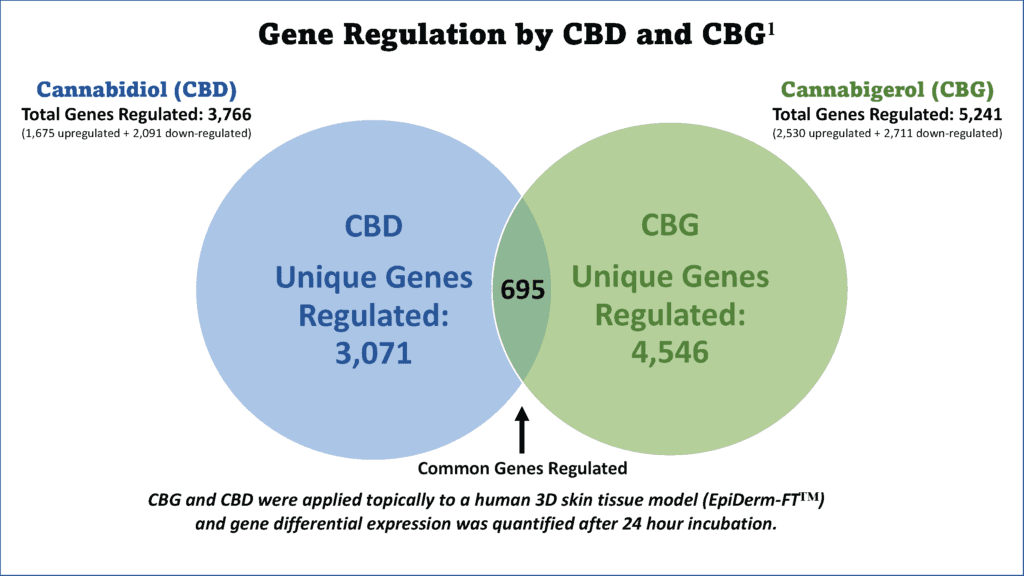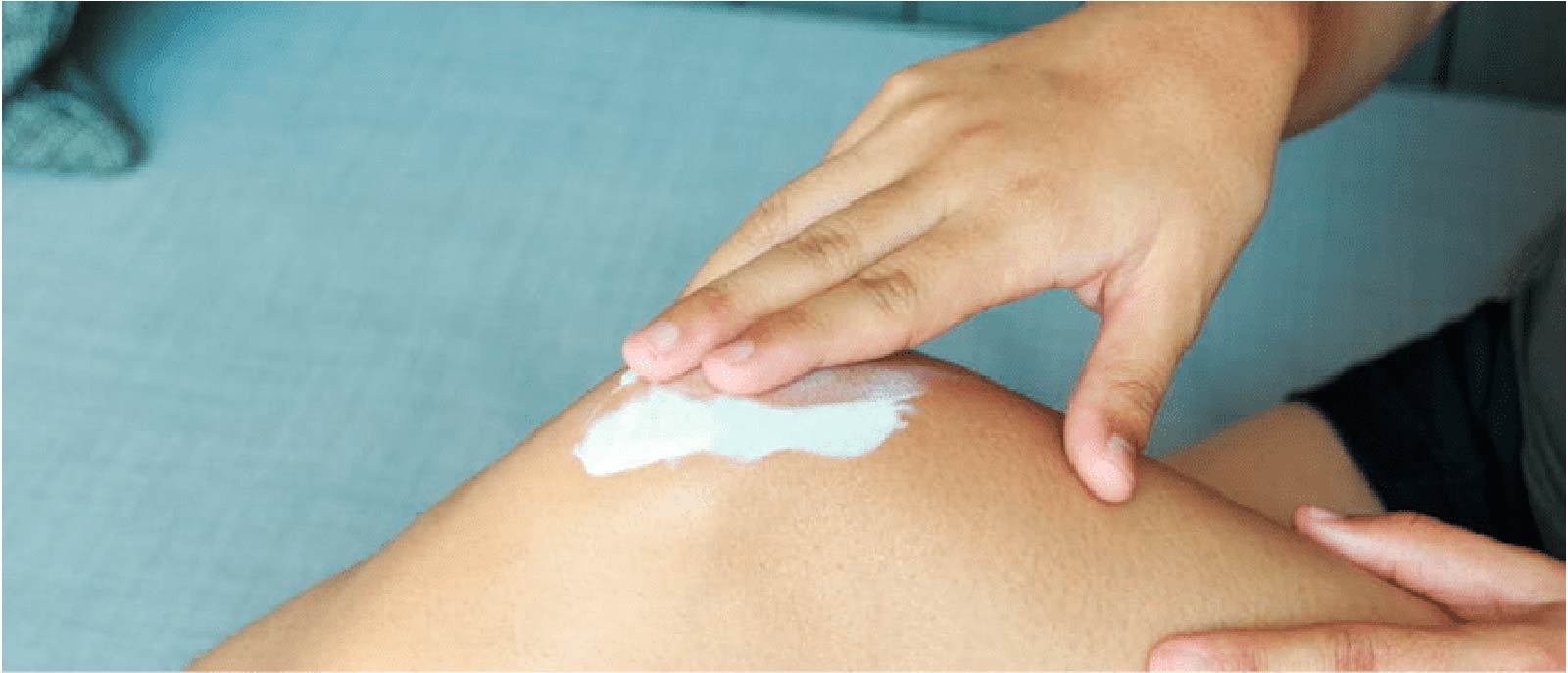Today, many topical products include cannabidiol (CBD) due to its diverse health benefits. Evidence shows that CBD can support many skin conditions by modulating inflammation and protecting the skin barrier, while also minimizing breakouts and easing discomfort from pain and itching.1
As research around cannabis continues to advance, so does further exploration into other cannabinoids found in the plant. Research now supports the significant health benefits of cannabigerol (CBG). Although it is considered a “minor” cannabinoid (since it manifests in trace amounts in the hemp plant), CBG is also considered the “mother of all cannabinoids” because it is actually the direct precursor for the other two most abundant cannabinoids, CBD and THC.
What is Known about CBG and How it Compares to CBD
Cannabigerol is the powerhouse “parent” molecule from which all other cannabinoids are formed. While research points toward CBG’s range of important benefits throughout the body, in this blog, we will discuss findings related specifically to skin health.
For starters, CBG and CBD don’t bind to the same receptors in the body. This distinction enables CBG to have some differing (and complementary) effects from those of CBD. Another key difference to note is that CBG regulates more genes than CBD, including many skin genes. Gene microarray analysis conducted using 3D human skin equivalents demonstrated that although both cannabinoids overlap on regulating 695 genes, CBD regulates 3071 unique genes, while CBG regulates 4546 unique genes—nearly 1500 more genes than CBD.

Overall, CBG and CBD are both found to modulate several key genes for skin aging, hydration, and inflammation.1 These cannabinoids help protect the skin and slow aging.
The gene analysis revealed that CBG selectively targets more skin genes than CBD, such as collagen, elastin and hydration genes.1 While CBG has an edge over CBD in skin-protecting activities, utilizing both maximizes overall benefits.
CBG and Oxidative Stress
Evidence also shows that both CBG and CBD possess potent anti-oxidant and anti-inflammatory properties, with CBG demonstrating slightly better activity than CBD. Results demonstrated that CBG and CBD both reduce reactive oxygen species (ROS) levels in human cells better than vitamin C.1 This is significant because elevated ROS can exacerbate skin aging and inflammation. ROS are also involved in the development of several allergic and inflammatory skin conditions, including psoriasis and others.3
CBG and Inflammation
CBD is previously known to be effective for chronic pain conditions such as discomfort associated with fibromyalgia, arthritis or sports-related injuries. A 2021 systematic review of 22 studies suggested that combining topical CBD and CBG may produce more of a potent anti-inflammatory effect than using one cannabinoid alone.5 Results showed a consistent reduction in pro-inflammatory cytokines such as TNFα (tumor necrosis factor-alpha,) interleukin (IL)-1β, IL-6, and interferon-gamma.4 Both CBD and CBG exhibit anti-inflammatory properties and can help reduce pain when applied topically. CBG and its constituents (CBGa) also inhibit COX-1 enzyme activity and exhibit strong activation of TRP-vanilloid receptors, which regulate sensation and pain.2
CBG and Ultraviolet-Induced Inflammation and Photo-aging
Chronic exposure to ultraviolet B (UVB) and ultraviolet A (UVA) can lead to a cascade of inflammation and pro-inflammatory cytokines that play a key role in skin photo-aging and skin disease. Study results demonstrated that when human cells were exposed to UVB, CBG inhibited TNFα (an inflammatory cytokine) release by twice as much as CBD.1 This effect was also seen when human cells were exposed to UVA, as CBG significantly inhibited IL-6 production, demonstrating a 50% maximum inhibition, as compared to CBD which reached a maximum inhibition of 27% of IL-6 production.1 CBG is shown to be a significant skin protector against UVB and UVA damage as these ultraviolet insults cause skin photo-aging by triggering inflammation and the breakdown of collagen.
ECS of the Skin
Though the skin is often viewed from a beauty perspective, it plays a vital role in health and well-being. Our body’s largest organ, the skin has its own endocannabinoid system (ECS). In fact, research has revealed that the skin contains a widespread distribution of cannabinoid receptors (CB1 and CB2).

Think of the skin ECS as a homeostatic modulator that acts to help balance all functions of the skin– protecting the skin from environmental-related insults, regulating activity in hair follicles and sebaceous glands, and modulating inflammatory response. With support from the ECS, the skin acts as a barrier that protects against pore-invading agents, such as foreign pathogens and toxins. For more information, view the “How CBD Supports the Skin Endocannabinoid System” blog.
Overall, the many research studies suggest that CBD and CBG may have a dual effect on inflammation when used together as they each target different inflammatory cytokines throughout the skin.
CBG and Acne
Acne may be partially caused by a dysfunction in the skin ECS. Research has shown that CBD acts as an effective suppressor of sebocyte proliferation. Recent research shows that CBG can be even more effective in reducing acne lesions and supporting clear skin, as it exhibits antibacterial properties and lipogenic activity in sebocytes.1
New research suggests that CBD and CBG exert varying actions on human sebocyte cells– not only for treating acne but also for skin conditions associated with compromised hyperproliferation, such as eczema and psoriasis.1 Both cannabinoids have been shown to possess strong antibacterial activity against acne. In terms of potency, CBG seems to outperform CBD in reducing acne-induced inflammation, making it an effective option to apply topically on acne-prone skin, alone or in combination with other cannabinoids.5
Overall, topicals containing CBG are well suited for acne patients or for individuals with dry skin and impaired barrier function, such as in eczema and psoriasis.5 This is due to CBG’s role in reducing the proliferation of keratinocytes along with it anti-inflammatory, anti-oxidative and anti-bacterial properties.
CBG and Skin Irritation
Another unpleasant chronic skin condition, dermatitis or eczema, is often triggered by environmental agents and systemic inflammation. In previous studies, CBD was shown to exert anti-inflammatory properties by activating CB2 receptors.
In recent research, CBG was also shown to reduce inflammation and provide skin barrier protection in individuals with dermatitis.1 A single-blind clinical study was performed in 20 healthy male and female individuals with SLS-induced contact dermatitis. Topical CBG was shown to be more effective than placebo in protecting the skin as it significantly improved skin barrier function.1 In addition, the application of 0.1% CBG serum after just 48 hours resulted in a significant reduction in redness and inflammation, better than placebo.
Altogether, these results indicate that CBG, when applied topically, clinically reduces skin inflammation and improves barrier function.
Best of Both Worlds
Research clearly shows exciting promise for numerous potential applications of topical CBG, along with CBD. Both are shown to modulate skin homeostasis and support skin barrier function. Beyond their overlapping activity, each contributes unique properties, making a combination CBG/CBD topical formula a synergistic and efficacious therapeutic for skin health.
References
1. Perez E, Fernandez JR, Fitzgerald C, Rouzard K, Tamura M, Savile C. In Vitro and Clinical Evaluation of Cannabigerol (CBG) Produced via Yeast Biosynthesis: A Cannabinoid with a Broad Range of Anti-Inflammatory and Skin Health-Boosting Properties. Molecules. 2022;27(2):491. Published 2022 Jan 13.
2. Kuprowsky, S. The Unusual Suspects: Minor and Acidic Cannabinoids and their Powerful Properties. ECS Therapeutics, February 2021.
3. Trouba KJ, Hamadeh HK, Amin RP, Germolec DR. Oxidative stress and its role in skin disease. Antioxid Redox Signal. 2002;4(4):665-673.
4. Henshaw FR, Dewsbury LS, Lim CK, Steiner GZ. The Effects of Cannabinoids on Pro- and Anti-Inflammatory Cytokines: A Systematic Review of In Vivo Studies. Cannabis Cannabinoid Res. 2021 Jun;6(3):177-195.
5. Farha, M. A. et. al. Uncovering the hidden antibiotic potential of cannabis. ACS Infect. Dis. 6, 338-346 (2020).

